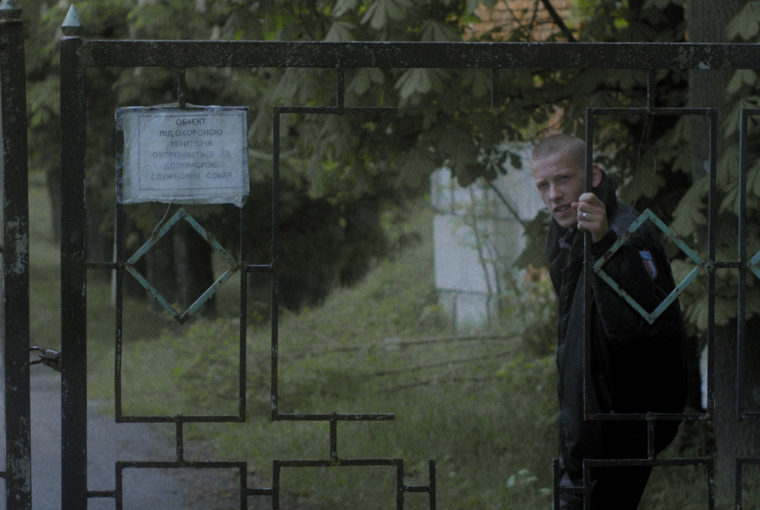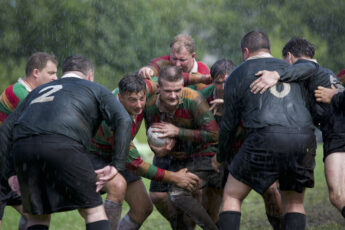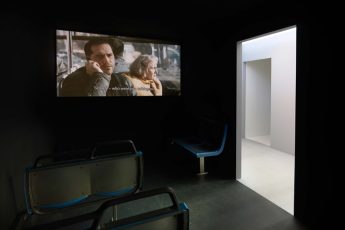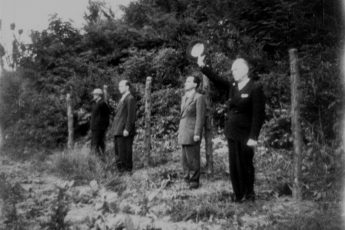"And Soon We Will Have Forgotten the Things We Know"
Micol Roubini’s The Way to the Mountains (La strada per le montagne, 2019)
Vol. 101 (January 2020) by Isabel Jacobs
In Franz Kafka’s unfinished novel The Castle (1926), the protagonist K. arrives in a remote village, desperately trying to gain access to a mysterious castle. An impervious bureaucracy refuses him entry for no apparent reason, and K. encounters hostile and inscrutable villagers. Everyone is protecting the castle — K.’s unobtainable object of desire — without knowing who the authorities are or what they do. After several desperate attempts to enter the castle, K. becomes more and more frustrated; distrust and alienation begin accumulating between him and the villagers. The castle is hidden in snow, mist and complete darkness and thus remains invisible most of the time.
We find a similar constellation, arguably in loose reference to Kafka’s novel, in Micol Roubini’s first feature-length documentary The Way to the Mountains. The Italian video-artist and her team arrive in Jamna, an abandoned village, formerly located in Poland and now part of Western Ukraine. Roubini attempts to trace her grandfather’s life in the village. Her path to his former home, a wooden house in Jamna, is blocked by a derelict metal gate and two Kalashnikov-armed guards. After several failed attempts to access the area, Roubini makes contact with Jamna’s locals and tries to figure out who owns the house now and what happened to her Jewish grandfather during World War II.
The filmmaker’s personal family history gradually intermingles with mysterious and dark tales about Jamna’s collective memory of the last century. On long walks around the forested mountains, Jamna’s deserted streets and the few remaining houses, Roubini collects stories and memories of the local population: one survivor remembers how, during the Nazi occupation, Jews, Poles and Ukrainians had to hide away in Jamna’s woods, barely nourished by some sap they had collected from the trees. Behind these same trees, which are patiently captured by Roubini’s camera in long shots, the partisans fighting the Germans took cover. We learn that, during the war, thousands of people had to flee from Jamna. Although today, neither Poles nor any Jews are left in the village, nobody really seems to speak about what has happened to them.
One of the film’s main aesthetic features is playing with its ambivalence of genre. By integrating fictional elements, sound and suspense, The Way to the Mountains is more of a docu-fiction or “docu-noir” (Lorenzo Esposito) rather than strictly documentary. While flirting with the documentary genre, Roubini creates an experimental video-collage containing interviews, photographs, film, music and her own voice-over. This polyphonic sound points to Roubini’s family history of emigration, the experience of foreignness, and the simultaneous presence of disparate cultural soundscapes. Roubini’s background in audio technology certainly contributed to the film’s experimental use of sound. The Way to the Mountains opens and ends with the same impelling sound, a rhythmized gong: in the opening scene, the gong appears when an inventory of her grandfather’s possessions is captured in a series of alternating photographs. In the end, the gong reappears, underlaying the snowfall and accompanying the last sentences of the voice-over: “And soon we will have forgotten the things we know.”
In an interview with Cineuropa, Roubini explains how initially, the search for her grandfather’s house had felt like “a real ‘cops and robbers’ story”, which then blended into a reflection on Jamna’s people “who have completely forgotten their own past.” Indeed, Roubini creates a story driven by the suspense of the locals’ opaque and incomplete stories. The goal of this semi-fictional narrative is to unearth the truth about her grandfather’s house which becomes “a metaphor for the dark recesses of memory”. Its physical inaccessibility reflects the suppressive character of memory. The house stands for a chain of traumatic events which are protected by armed guards; nobody knows who employs these guards and why they prevent people from accessing the area. As is the case in Kafka’s novel, communication in The Way to the Mountains is full of misunderstanding and confusions; all stories about the house contradict each other and, in the end, nobody seems to know anything about the house’s fate. Clearly, Roubini challenges the belief in one ‘true’ history behind this plethora of stories.
Locals like Petro, a former partisan, or Yura, a taxi driver, become characters acting in several scenes that seem staged rather than spontaneous. The director’s decision to stage some actions and to transform locals into dramatic figures can be read as a critique of documentary realism and authenticity as such. In a recognizably postmodernist spirit, The Way to the Mountains problematizes the nature of reality and suggests that this reality cannot be real until it is staged. Roubini does create intimate moments while playing with the role of artifice in documentary storytelling. In one scene, we see the taxi driver Yura performing his private morning routines quite naturally, first appearing asleep, then slowly getting dressed in front of the camera. We also see Petro, the old partisan, going back to the forest where he used to fight. Walking through the woods, he recalls the partisan’s deep fear of being discovered, and his loss of fellow partisan and lover Marika. Before walking deeper into the forest and disappearing between the trees, Petro takes stock: he himself has lost some fingers; Marika has left. A whole life has passed. In this scene, the combination of personal memory and meticulous mise-en-scène creates a rarely promising moment of Roubini’s film which is supported by the perceptive and patient camerawork of cinematographer Davide Maldi.
Referring to The Way to the Mountains as a “docu-noir,” we can find some clear aesthetic allusions to the film noir: the film gets darker and darker and somewhere in the middle we find ourselves on gloomy roads, barely lit by the streetlights, until even the lampposts stop working during the night. One scene is shot in deep black and appears like a half-satirical reenactment of Béla Tarr’s philosophical dialogues, held in darkness on a muddy street: Petro and Yura are chain smoking and theatrically staring into the emptiness; during their nocturnal dialogue, the two old men claim, “there was no order and will never be.” They also recall how Jamna’s Jews had escaped barefoot over the very same road on which they stand until “the road was covered with the blood of their feet.” But the effect of this dramatic statement is unconvincing, discomforting and somehow false.
Such a feeling of discomfort was my persistent impression regarding The Way to the Mountains. It is linked with some of the film’s ideological implications: in particular, the suspense is too artificial to be convincing and involve the viewer’s emotions. In the voice-over in Italian, Roubini explains how the mistrust between her and the villagers accumulates to create a “sudden anxiety.” My sobering question in response would be: is mistrust such a surprising attitude towards a foreign film team intruding into a village for several weeks to film without permission?
Roubini frames this mistrust as a collective repression of the past and even an unconscious censorship of her film. Ukraine’s public institutions are depicted as an unfathomable apparatus that systematically prevents Roubini from finding out the truth. Together with a veteran, the film team visits a war memorial museum. Without asking for permission, an unidentified group of men show the museum director a photograph and ask her questions about it — the camera is running all the time, although the museum director repeatedly asks them to stop filming. It is not a secret that post-Soviet bureaucracy easily appears Kafkaesque — but in this case it feels like the museum director’s reaction is deliberately provoked to sustain the film’s narrative. In a state of disorientation, she prevents the unidentified men from further filming in the museum and states: “You didn’t even introduce yourselves. You could be anyone, maybe even separatists!”
Does Roubini’s documentary merely aim at making visible other realities while using slightly impudent methods? I would argue that the ethical implications of her film are more severe. The fetishization and exploitation of everyday life in remote villages at the peripheries of Europe — the more marginal and run-down the better, preferably related to the Chernobyl catastrophe or the Holocaust — has enjoyed growing interest in recent years. Young filmmakers and art school graduates end up stranded with their cameras at some margin of the Post-Soviet space, looking for a ‘story’ that conveys an experience more primordial and authentic than the post-modern ennui of their bubbles in Antwerp, Berlin or Milan. This form of labored authenticity is of course not sufficiently authentic until the documentary filmmaker involves local people in the stories she wants to tell. In Transnistra (2019), Swedish director Anna Eborn portrays the intimate struggles of teenagers in the unrecognized republic of Transnistria, juxtaposing her shots with Soviet rock music.
Another instance of this new ‘documentary anti-realism’ is the immersive performance project Zvizdal [Chernobyl – so far so close] (2016) by the Antwerp artist duo Berlin (Bart Baele and Yves Degryse). Zvizdal is a ‘documentary’ intermedia installation with two film screens and a miniature installation of the house where Pétro and Nadia live; they are over 60 years old and the last two inhabitants of Zvizdal, a radiated ghost town in the exclusion zone of Chernobyl. Between 2011 and 2016, Baele and Degryse were portraying the couple’s difficult daily life: “There is the lack of electricity, of running water and heating. There are the superstitions, there is the vodka, the muttering, the cursing and praying and singing, the toothaches, the ailments of old age, the 20-km walk to the nearest shop, the wait for someone from civilization.” The exploitation of these peoples’ lives becomes apparent, at the very latest, when the artists even document the death of one of their ‘protagonists’ – fed to the greedy art world of Western Europe’s capitals.
There is no doubt that Roubini’s portray of Jamna is aligned with this slightly exoticizing form of anti-documentary. In a scene exemplifying the film’s cultural voyeurism, the obligatory Slavic booze-drinking is celebrated: Jamna’s few inhabitants are drinking vodka and our protagonists are dancing in white-blue-red tracksuits to trashy music, the whole scenery lit by blue spotlights projecting circular patterns onto the yellowed walls. This is reality, but it does not seem real.




Leave a Comment